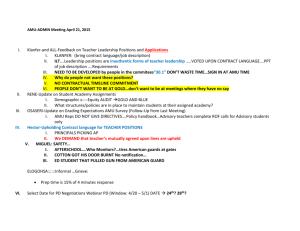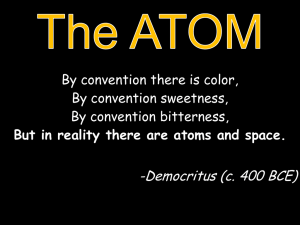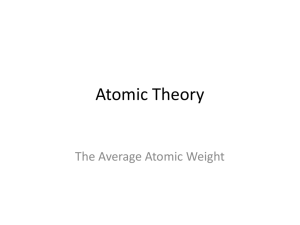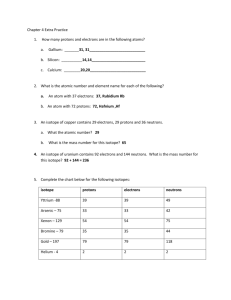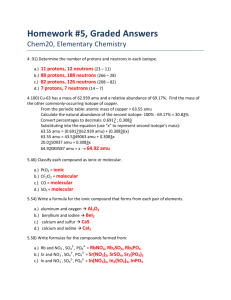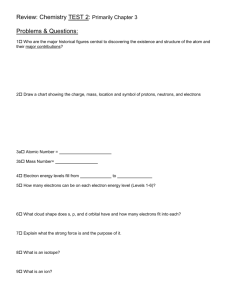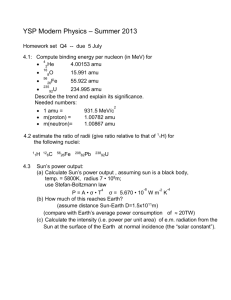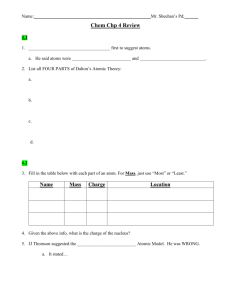File
advertisement
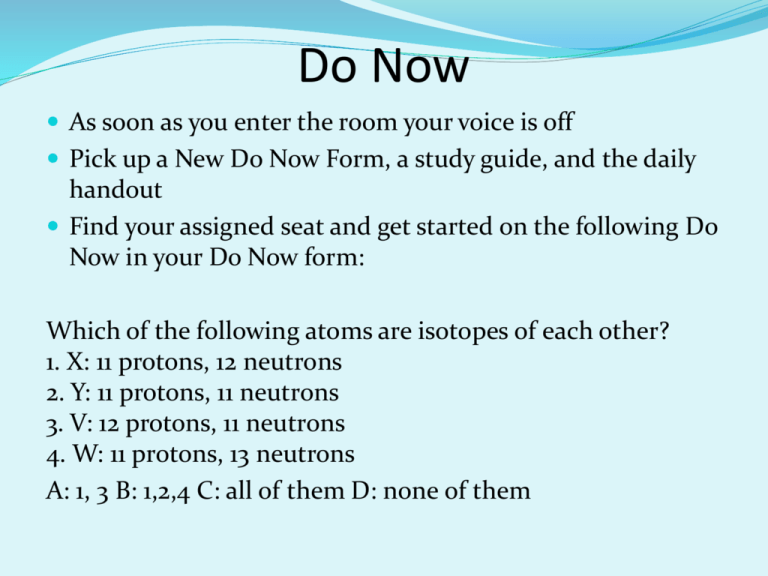
Do Now As soon as you enter the room your voice is off Pick up a New Do Now Form, a study guide, and the daily handout Find your assigned seat and get started on the following Do Now in your Do Now form: Which of the following atoms are isotopes of each other? 1. X: 11 protons, 12 neutrons 2. Y: 11 protons, 11 neutrons 3. V: 12 protons, 11 neutrons 4. W: 11 protons, 13 neutrons A: 1, 3 B: 1,2,4 C: all of them D: none of them Review of Procedures 1. 2. 3. 4. 5. Raise your hand to speak and wait to be recognized If I don’t answer your question – put it on a sticky note and put it in the parking lot before you leave. Do not get up out of your seat without permission. No heads down. Enter silently, pick up any handouts, find your assigned seat, start the Do Now immediately. All atoms of the same element have the same number of protons, but the number of neutrons may vary. Isotopes are atoms of the same element which have different numbers of neutrons. Isotope Oxygen – 16 Oxygen – 17 Oxygen - 18 Nuclear Number Symbol of Protons 8 8 8 Number of Electrons 8 8 8 Number Mass of Number Neutrons 8 9 10 16 17 18 Mass (amu) 15.99415 16.999131 17.999160 What structural characteristics do all oxygen atoms have in common? All oxygen atoms have the same number of protons and electrons. What differences exist between the isotopes of oxygen? The mass number, number of neutrons and mass of each isotope are different. The isotopes of an element do not differ significantly in their chemical behavior. Why do you think this is so? The chemical behavior is determined by the number of electrons and they all contain the same number of electrons. The average atomic mass for an element is given on the periodic table, but how was it determined? In order to calculate the average atomic mass for an element, you must know the percent abundance and atomic mass for each of the isotopes of that element. Isotope Atomic Mass Oxygen – 16 Oxygen – 17 Oxygen – 18 15.99415 amu 16.999131 amu 17.999160 amu Percent Abundance 99.762% 0.038% 0.200% The average atomic mass of oxygen is given as 15.999 amu on the periodic table. Let’s see how that was calculated. 15.99415 amu × = 15.95608 amu 16.999131 amu x = 0.0064597 amu 17.99160 amu × = 0.03598 amu 15.95608 amu + 0.0064597 amu + 0.03598 amu = 15.999 amu A certain element exists as three natural isotopes as shown in the table below. Isotope Mass (amu) Percent Abundance Mass Number 1 19.99244 90.51 20 2 20.99395 0.27 21 3 21.99138 9.22 22 Calculate the average atomic mass of this element to the nearest thousandth. 19.99244 amu × 20.99395 amu × 21.99138 amu × = 18.09515744 amu = 0.056683665 amu = 2.027605236 amu 18.09515744 amu + 0.056683665 amu + 2.027605236 amu = 20.179 amu Identify the element. Neon Carbon has three naturally occurring isotopes: Carbon-12 (12.000 amu), Carbon13 (13.003 amu), and Carbon-14 (14.003 amu). Based upon the average atomic mass of carbon (12.011 amu), which isotope of carbon do you think is the most abundant in nature? Explain your answer. Carbon-12 is the most abundant in nature. This answer is based on the fact that the average atomic mass of carbon is 12.011 amu which is closest to the mass of carbon12. An element has two naturally occurring isotopes. The mass of the first isotope is 64.9278 amu and the mass of the second isotope is 62.9296 amu. The average atomic mass of the element is 63.546 amu. Calculate the percent abundance of each isotope to two decimal places. Let x = the percent as a decimal of the first isotope. 1-x = the percent as a decimal of the second isotope. (64.9278)x + (1-x)(62.9296) = 63.546 64.9278x + 62.9296 – 62.9296x = 63.546 1.9982x = 0.6164 x = 0.3085; 1-x = 0.6915 The percent abundances are 30.85% and 69.15%. Beanium Be sure to have all information and calculations recorded for the Beanium activity from Friday Using the Cl-Ev-R model to report on activity Ions are formed when an atom gains or loses electrons. • anion – negatively charged ion formed when an atom gains electrons • cation – positively charged ion formed when an atom loses electrons We will talk more about ions later this year. • determined by the number of protons in the nucleus • found on the periodic table Determine the atomic number for each of the following elements. Li 3 N 7 12 Mg • equal to the sum of the neutrons and protons in the nucleus of an atom • not given on the periodic table Ways to indicate mass number: •Hyphen notation Chlorine-35 •Nuclear Symbol Beryllium-9 Determine the number of neutrons in Argon-40. The atomic number for argon is 18. 40 - 18 = 22. Element (hyphen notation) Nuclear Symbol Atomic Mass Number Number Number Number Number of of of Protons Neutrons Electrons Sodium -22 11 22 11 11 11 Fluorine-19 9 19 9 10 9 Bromine-80 35 80 35 45 35 Calcium-40 20 40 20 20 20 Hydrogen-1 1 1 1 0 1
